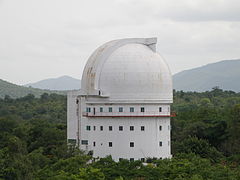Vainu Bappu Observatory

The 93-inch telescope seen from the 40-inch telescope at Vainu Bappu Observatory
|
|||||
| Organization | Indian Institute of Astrophysics | ||||
|---|---|---|---|---|---|
| Location | Kavalur, Vellore, Tamil Nadu, India | ||||
| Coordinates | Javadi Hills, Alangayam, Kavalur, Tamil Nadu 635701 | ||||
| Altitude | 700 m (2,297 ft) | ||||
| Established | 1986 | ||||
| Website | Vainu Bappu Observatory | ||||
| Telescopes | |||||
|
|||||
|
[]
|
|||||
| Vainu Bappu Telescope | 2.3 m reflector |
|---|---|
| Carl Zeiss telescope | 1 m reflector |
The Vainu Bappu Observatory is an astronomical observatory owned and operated by Indian Institute of Astrophysics. It is located at Kavalur in the Javadi Hills, near Vaniyambadi in Vellore district in the Indian state of Tamil Nadu. It is 200 km south-west of Chennai and 175 km south-east of Bangalore.
The Vainu Bappu Observatory of the Indian Institute of Astrophysics traces its origin back to 1786 when William Petrie set up his private observatory at his garden house at Egmore, Madras, which eventually came to be known as the Madras Observatory. Later it was moved to Kodaikanal and functioned there as the Kodaikanal Observatory since 1899.
However, Kodaikanal had very few nights available for observation and hence astronomers searched for a new site after India's independence.M.K. Vainu Bappu who took over as the director of the Kodaikanal Observatory in 1960, found a sleepy little hamlet called Kavalur in the Javadu Hills as a suitable site for establishing optical telescopes for observing celestial objects. This came to be known as Kavalur Observatory.
Observations began in 1968 with a 38 cm telescope made in the backyard of the Kodaikanal Observatory.
Kavalur observatory is located in Kavalur in the Javadi Hills in Alangayam, Vellore District. The Kavalur Observatory is located in a 100-acre forest land in Tamil Nadu which is strewn with a variety of greenery of tropical region besides a number of medicinal plants with an occasional appearance of some wildlife like deer, snakes and scorpions. Several varieties of birds have also been spotted in the campus. The observatory is at an altitude of 725m above mean sea level (longitude 78° 49.6' E ; latitude 12° 34.6' N). Apart from being reasonably away from city lights and industrial areas, the location has been chosen in order to be closer to the earth's equator for covering both northern and southern hemispheres with equal ease. In addition, its longitudinal position is such that it is the only major astronomical facility between Australia and South Africa for observing the southern objects.
...
Wikipedia
